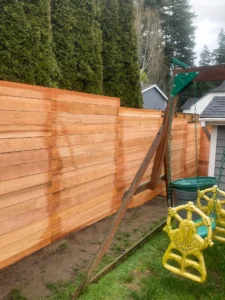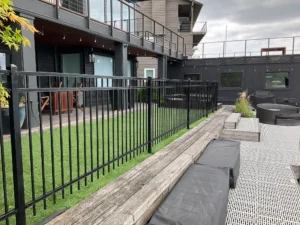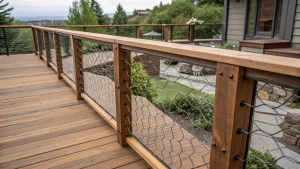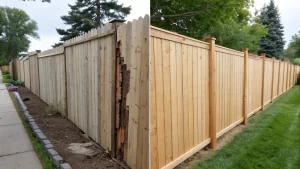Inline Fence helps Seattle homeowners decide: repair or replace your cedar fence?
When your cedar fence starts showing its age, you’re faced with a classic homeowner dilemma — should you repair what’s there or invest in something new? For many Seattle-area residents, this is more than just a budget question, but it’s about balancing property value, privacy, and the unique challenges of your Seattle yard in the damp Northwest climate, while ensuring you get the best value for your investment.
On one side, fence repair can often solve problems like broken panels, loose posts, or minor rot without requiring a full overhaul. On the other, cedar fence replacement may ultimately save money and stress if the structure is nearing the end of its lifespan or has widespread issues.
This decision is especially important in Seattle, where heavy rainfall, moss growth, and seasonal storms can shorten the lifespan of wood structures. Homeowners need to weigh not only the immediate cost but also the long-term resilience of their fencing.
In this article, we’ll walk through how to assess your fence’s current condition, when repair makes sense, and when replacement becomes the smarter choice. We’ll also look at local cost comparisons, modern fencing options, and practical decision-making tips tailored for Seattle homeowners. For guidance and professional service, Inline Fence can help assess your property and recommend whether repair or replacement is the best option.
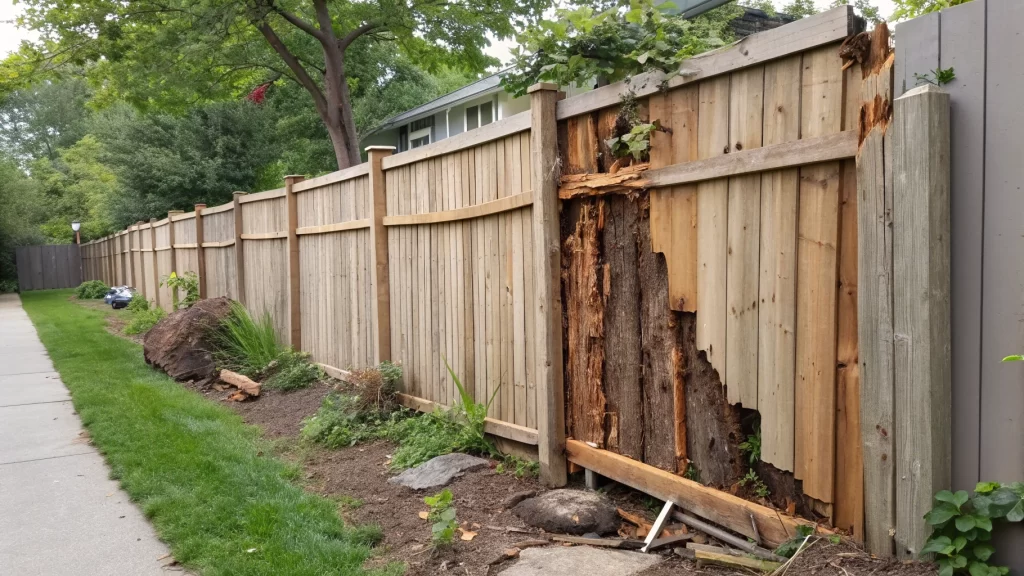
Understanding your cedar fence condition
Before deciding on repair or replacement, it helps to step back and assess the true condition of your cedar fence. Cedar, particularly western red cedar, is one of the most durable wood options, but even the best materials eventually show wear — especially in Seattle’s wet and moss-prone environment.
Start with a basic visual inspection to find any areas needing attention. Look for obvious signs of damage: cracked or warped boards, rot near the base, loose posts, or heavy discoloration. These problems don’t always mean you need a brand-new structure; sometimes targeted fence repairs are enough.
Age is another major factor. A cedar fence that’s been standing for over 15 years may have widespread issues, while a newer fence might only need spot attention. Keep in mind that cedar naturally weathers to a silvery-gray over time — this isn’t always damage, but if combined with soft wood or splintering, it may indicate deeper problems.
It’s also important to distinguish between local and systemic damage. If one or two posts are compromised, replacing them may be enough. But if rot, leaning, or loose hardware is consistent along the entire length, your fence may be structurally unsound.
Seattle homeowners in particular should watch for damage patterns tied to the local climate. Frequent rain can cause water pooling around posts, moss growth can weaken boards, and occasional windstorms may create pressure points.
A simple homeowner checklist might include:
- Are posts firm when pushed?
- Is there visible rot or soft spots at the base?
- Do boards show large cracks or warping?
- Is hardware rusted or loose?
By taking a clear-eyed look at your cedar fencing, you’ll have the foundation for deciding whether to repair or replace.
⭐⭐⭐⭐⭐
“We had a couple of fence panels that needed replacing after a windstorm blew them down. After contacting several fence companies, none of them returned my calls, but Inline Fence did and address my concerns promptly. They came out and surveyed the damage and within hours I got a quote on the costs for the repairs. The workers were very considerate about not damaging the flower beds and surrounding areas and cleaned up after doing the job.”– Mark
When cedar fence repair makes sense
Not every issue with a cedar fence calls for a full replacement. Sometimes, fence repair is the smarter, more cost-effective option — especially when damage is isolated or the fence is relatively young. Repairing fences can restore access and function without the larger expense and disruption of replacement.
From an economic perspective, small-scale cedar fence repair often costs a fraction of installing a new fence, and it allows homeowners to extend the life of their existing structure. Even in Seattle’s wet climate, targeted cedar fence repair can address rot, cracked boards, or loose posts before problems spread.
The key is understanding the scenarios where repair truly makes sense. Below, we’ll explore common repair situations, the technical aspects of spot fixes, and strategies for keeping your cedar fence in top shape for years to come.
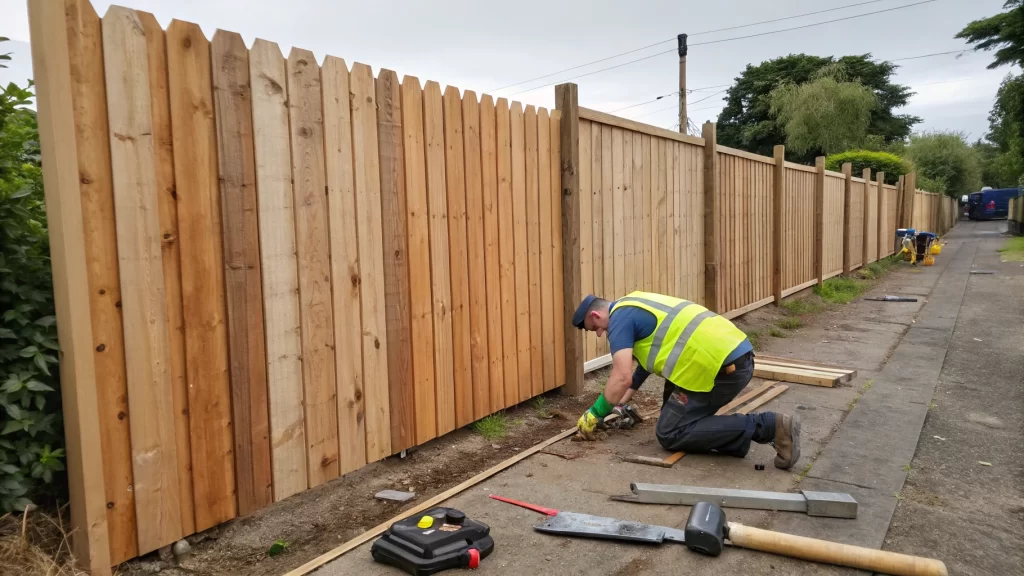
Common cedar fencing repair scenarios
When it comes to fence panel repair, the most common situation is a single damaged section that doesn’t affect the rest of your cedar fence panels. Replacing individual boards or posts can quickly restore both function and aesthetic appeal without a full overhaul.
Minor cracks, loose boards, or warped panels can often be addressed by removing the affected section and installing a new cedar piece. Hardware issues, like rusted nails or loose screws, are usually inexpensive fixes that improve stability and safety. Repairing fencing at this level is typically completed in a day or two for an average backyard fence, making it a practical option for Seattle homeowners who want minimal disruption.
Cost and timeline considerations vary depending on the types of repairs needed and the extent of damage to your cedar fence panels. According to Angi (2025), small-scale fence repairs generally range from $150 to $400 per panel, while HomeGuide (2023) lists similar costs for wood fence repairs. Labor in Seattle can push the total higher, especially if posts need to be reset in damp soil.
Other repairable issues include localized rot at the bottom of a post, minor staining or discoloration, and leaning sections caused by wind or soil movement. By focusing on these targeted fixes, you can extend the life of your cedar fence panels and avoid the expense of a full replacement.
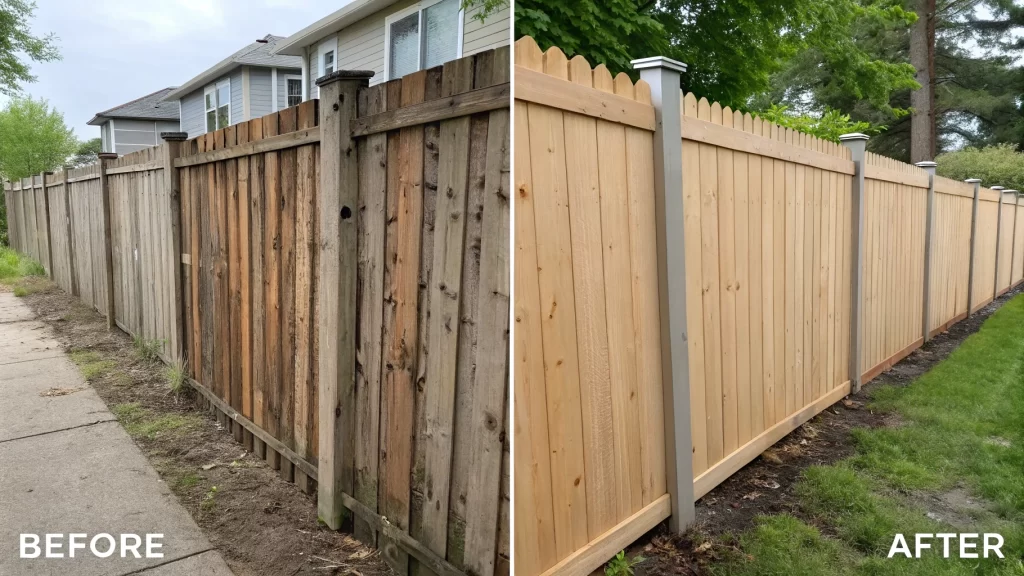
Cedar fence maintenance strategies
Proper cedar fence maintenance is the key to extending the lifespan of your cedar fence and protecting your investment. Regular care helps prevent small issues from turning into costly repairs, especially in Seattle’s rainy, moss-prone climate.
Start with routine inspections each season. Check for loose boards, leaning posts, and early signs of rot. Cleaning your fence with mild soap and water removes dirt, moss, and mildew that can accelerate decay. Applying a high-quality sealant or stain every 2–3 years provides an extra layer of protection against moisture and UV damage.
Cedar fence maintenance also includes keeping the base of a post clear of soil or mulch buildup to reduce water exposure. Trim nearby vegetation that may trap moisture against the wood. Even small preventive steps, like tightening screws or replacing worn hardware, can make a big difference over time.
Seasonal schedules are helpful, allowing homeowners to plan tasks throughout the year to meet Seattle’s weather challenges and protect their cedar fence. Spring is ideal for cleaning and inspection, summer for staining or sealing, and fall for minor repairs before the rainy season sets in. With consistent cedar fence maintenance, homeowners can save money on major repairs and keep their fences looking attractive for years.
Need help deciding between repairing or replacing your cedar fence? Inline Fence offers expert inspections for Seattle homeowners — schedule yours today!
When replacement is the better choice for your cedar fence
Sometimes, repairing a cedar fence just isn’t enough. In cases where structural damage is widespread, posts are rotting, or boards are consistently failing, cedar fence replacement becomes the smarter long-term investment. While repair can temporarily fix localized issues, repeated fixes may end up costing more than a new fence in the long run.
Seattle homeowners, in particular, face challenges like persistent moisture, moss accumulation, and occasional wind damage that can accelerate wear. When multiple sections of your cedar fencing show signs of decay or the fence has exceeded its expected lifespan, replacement ensures safety, compliance with local building codes, and lasting aesthetic appeal.
Below, we’ll explore the critical signs that indicate a full replacement is necessary and review modern options for Seattle-area properties.
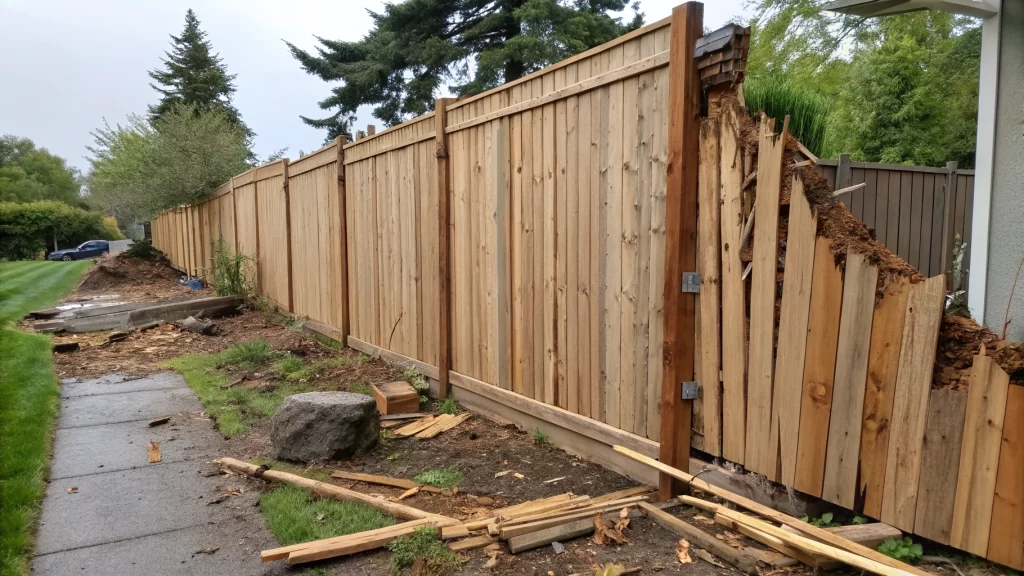
Signs you need a full replacement
Not all fences are candidates for simple repair. Certain conditions make cedar fence replacement the safer and more cost-effective choice. One clear sign is widespread structural damage. When multiple posts are rotting or leaning, or when boards along the entire length of the fence are warped or cracked, patchwork repairs may only delay the inevitable.
Age is another factor. Cedar wood fence panel typically lasts 15–20 years with proper care. If your fence has exceeded that range, or if repeated repairs have already been made, cedar fence replacement is often the wiser investment rather than throwing money at recurring problems.
Safety concerns and compliance with local building codes also play a role. A failing cedar wood fence can collapse, creating hazards for children, pets, or property, and may violate Seattle’s fence height and setback regulations.
Finally, cosmetic damage that affects the overall aesthetic — such as severe discoloration, splintering, or moss-covered sections — can signal the need for full replacement. Modern cedar fencing panels provide more durable, weather-resistant options that maintain their look and function for decades, making the investment worthwhile for Seattle homeowners focused on long-term value.
Modern cedar fencing options
For Seattle homeowners considering cedar fence replacement, modern western red cedar options offer both durability and style. A cedar privacy fence is a popular choice, providing height, security, and a clean aesthetic that complements many local home styles. These fences are designed to withstand the region’s rain and occasional wind while maintaining a natural wood appearance.
Homeowners can choose from a variety of cedar wood panels for fence, including horizontal and vertical designs, tongue-and-groove boards, and pre-assembled sections for faster installation. Each cedar privacy fence panel can be tailored to suit specific property needs, whether you want full privacy, decorative spacing, or a mix of both.
New cedar fencing panels often feature improved weather-resistant treatments and kiln-dried wood to reduce warping and splitting over time. Contemporary designs also allow homeowners to customize their fences — whether through staining, painting, or leaving the wood natural — to match landscaping or architectural style.
Investing in modern cedar options not only enhances curb appeal but also ensures long-term performance in Seattle’s climate. Paired with proper installation and routine care, these fences can provide decades of reliable privacy and visual appeal.
Whether it's a simple repair or a full replacement, Inline Fence can guide Seattle homeowners to the right solution. Get your professional fence assessment now.
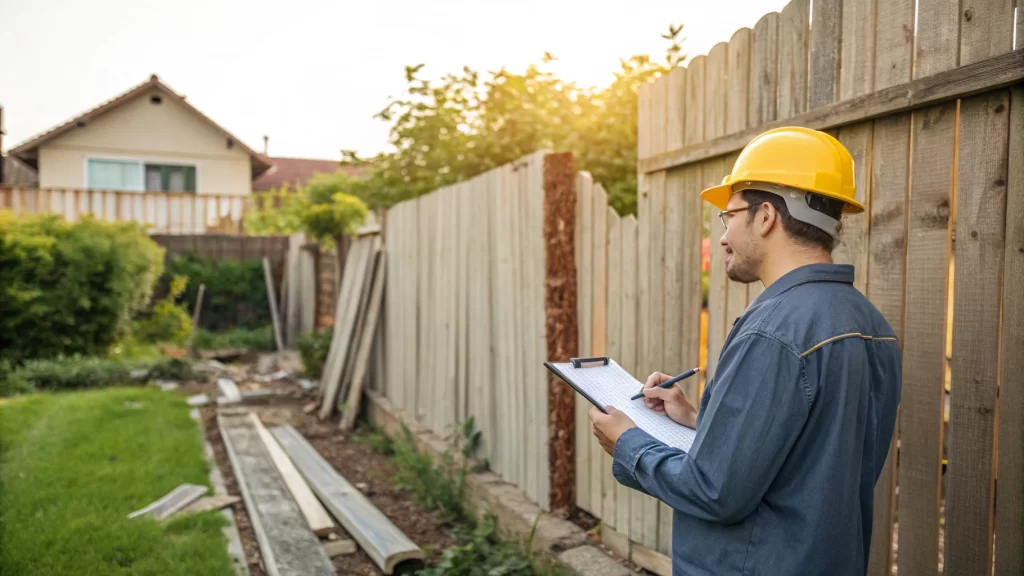
Cost comparison: repair VS replacement
It’s important to consider the financial impact when weighing the options of repairing versus replacing your cedar fence. Small-scale cedar fence repair is typically less expensive upfront. According to Angi (2025), minor repairs such as replacing individual boards or fixing posts range from $150 to $400 per panel, while HomeGuide (2023) lists general wood fence repairs between $250 and $750. Labor in Seattle can increase costs slightly, with average rates around $32 per hour (Home Builders Institute, 2024). Seattle’s construction costs have risen recently, with the Mortenson Construction Cost Index showing a 2.37% increase in Q2 2025 and BLS data reporting above-average local wages, which can influence labor costs for both repairs and full fence replacement.
On the other hand, cedar fence replacement involves higher upfront costs but may offer long-term savings. Installing a new fence, including materials and labor, generally ranges from $25 to $45 per linear foot — with totals climbing as projects require more feet of fencing in larger yards (HomeAdvisor, 2025). Using modern cedar fence panels ensures longer durability, reducing maintenance and the need for frequent repairs. Material costs for cedar lumber have recently averaged $590 per thousand board feet (Trading Economics, September 2025), slightly above the national average due to local supply constraints.
Hidden expenses can make repairs more costly than they appear. Repeated fixes, treating extensive rot, or replacing posts set in damp Seattle soil may quickly approach the cost of a full replacement, while investing in a new fence can improve longevity, reducing future maintenance and repair needs. Conversely, investing in a full cedar fence replacement provides peace of mind, compliance with local regulations, and a fresh aesthetic that can enhance your property’s value.
Ultimately, short-term savings from fence repairs should be weighed against the potential for ongoing maintenance, weather-related damage, and labor costs unique to Seattle. A carefully evaluated decision ensures the best balance between cost, durability, and long-term satisfaction.
Cedar fence repair cost factors
Several elements influence cedar fence repair costs, especially in Seattle’s wet climate. The type of cedar wood matters most — high-quality western red cedar usually costs more but lasts longer, making repairs more worthwhile. The length of fence that needs attention also plays a role — repairing more feet of panels or posts naturally drives labor and material costs higher. If your yard layout is complex, this fact can add extra charges for crews bringing tools and replacement panels. Seattle homeowners also need to consider hardware, sealant, and finishing products, which contractors often add to the final estimate. Even small upgrades, such as adjusting gates or replacing hardware, can increase expenses. For properties where the project scope in yards includes multiple sections, costs can approach those of partial replacement. Ultimately, repair pricing depends on the balance of materials, labor, and the extent of damage, making each project unique.
Full replacement: fence panels and installation costs
When damage is extensive, a full cedar fence replacement may be the most cost-effective solution. Installing fresh panels made of durable western red cedar ensures long-lasting performance in Seattle’s damp environment. Material costs rise as more feet of fencing are required, especially when the project in yards includes multiple boundaries or corner transitions. Homeowners often add custom features during replacement, such as upgraded gates, decorative tops, or fencing gates designed for easier way. Contractors typically provide itemized quotes so you can see what’s included in the cart of materials and labor. On average, Seattle homeowners spend $25 – $45 per linear foot for new cedar panels and installation, with gates or demolition work adding to the total. Options to customize your fence — whether through panel style, stain finish, or additional privacy features — also influence costs. For projects where yards includes long stretches, totals can easily exceed $8,000 – $12,000, yet these investments add both value and durability to your property.
Making your decision: key factors for cedar wood fence projects
Deciding whether to repair or replace your cedar fence requires weighing factors like cost, longevity, and overall value to your property. Start by evaluating the overall condition of your cedar fence — is damage localized or widespread, and how old is the structure? Targeted issues may justify repairing fencing, while extensive decay or structural instability often calls for replacement.
Consider your personal priorities as a Seattle homeowner. If you want minimal disruption and lower short-term costs, fence repair may be the practical route. However, investing in a full cedar fence replacement can reduce ongoing maintenance, improve safety, and enhance curb appeal with modern materials and designs that you can customize to fit your property’s style.
When in doubt, call a professional for assessment. An experienced installer like Inline Fence can inspect your property, outline repair options, or recommend replacement if needed. This ensures you make an informed decision that protects your investment and keeps your outdoor space safe and attractive.


